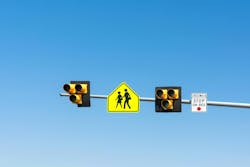Confusion Over Massachusetts’ New Hybrid Traffic Signals Raises Safety Concerns
Key Takeaways
- MassDOT installed 40 hybrid pedestrian signals statewide to improve safety, but many drivers remain confused about how to respond.
- A UMass Amherst study found 24% of drivers ran solid red lights and 65% rolled through flashing reds without stopping.
- Four-lane roads showed the highest rate of violations, with nearly 70% of drivers ignoring flashing red phases.
New hybrid traffic signals installed across Massachusetts are designed to enhance pedestrian safety — but many drivers aren’t getting the message. Nearly a quarter of motorists are running through red lights at these crossings, raising concerns for roadway safety and pedestrian protection.
According to Boston.com, 40 hybrid traffic lights — also known as pedestrian hybrid beacons — have been statewide. These signals remain off when no pedestrians are present but activate through a five-phase lighting cycle when pedestrians request to cross.
A flashing yellow light alerts drivers to slow down, while a solid yellow indicates they should prepare to stop. A solid red light requires a full stop as pedestrians are actively in the crosswalk, and a flashing red allows drivers to proceed once the crosswalk is clear, Axios Boston reported. When the lights are off, traffic may proceed normally.
Drivers Struggle to Adjust
Although the Massachusetts Department of Transportation (MassDOT) released an instructional video in 2021 explaining how to navigate these signals, driver compliance remains low, Boston.com reported.
A study by UMass Amherst found that 24% of drivers drove through solid red lights, while 65% failed to stop during flashing red phases. The report also revealed that only 30% of drivers stopped correctly at yellow signals, and 9% stopped unnecessarily when no lights were displayed.
According to Axios Boston, many drivers either rolled through crosswalks without stopping or stopped prematurely, creating unpredictable conditions for both pedestrians and other vehicles.
Higher Risks on Wider Roads
The study found more violations on four-lane roads, where 29% of drivers ran solid red lights and 69% ignored flashing red signals before proceeding. In contrast, two-lane urban roads saw fewer violations — only 11% of drivers failed to stop at solid reds, Boston.com reported.
Experts note a “domino effect” can occur when drivers slow too early or misread the signal. When vehicles in front stop unnecessarily, drivers behind may assume the crosswalk is clear and proceed through a red light, Axios Boston noted.
The confusion is particularly dangerous in shared-use corridors, where runners and cyclists may move through the crosswalk too quickly for distracted drivers to react.
Sources: Boston.com, Axios Boston
